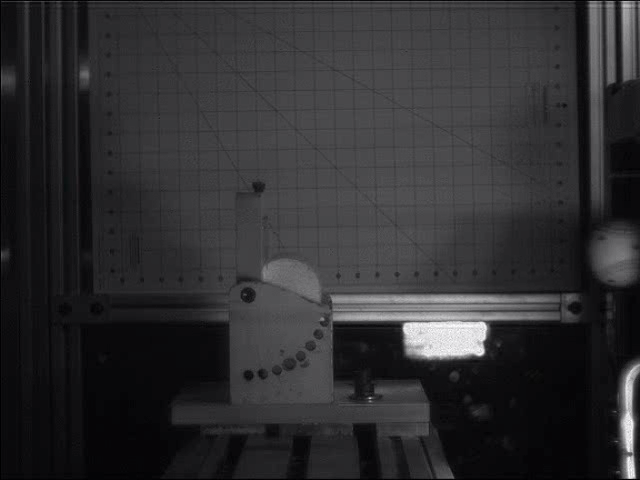The Baseball-Bat Collision

HIGH-SPEED VIDEO OF A BALL MAKING AN OBLIQUE COLLISION WITH A FIXED CYLINDRICAL SURFACE. NOTE THAT HE BALL, INITIALLY NOT SPINNING, HITS THE UPPER HALF OF THE CYLINDER AND SCATTERS UPWARD WITH BACKSPIN.
This video was part of an experiment to study the spin of a batted ball.
The paper reports results of experiments that were conducted to investigate the spin of a baseball undergoing an oblique collision with a bat. A baseball was fired horizontally at speeds up to 120 mph onto a 3"-diameter cylinder of wood that was rigidly attached to a wall. In one experiment, a two-wheel pitching machine was used in which the backspin or topspin of the incident ball could be adjusted.
In another experiment, an air cannon was used to project the ball with no spin.
In both experiments, markers on the ball were tracked with high-speed video to determine the velocity and spin vectors, before and after the scattering.
Our primary results are as follows: (1) For a given angle of incidence, the scattered spin is nearly independent of the incident spin; (2) The spin of the scattered baseball is considerably larger than expected for a model whereby the ball rolls before leaving the surface.
Implications for the spin of batted baseballs is disussed.
The Grip Doesn't Matter
On May 27, 2012, Todd Frazier hit a home run with his hands barely gripping the bat. In the video clip, note that the top hand is not in contact with the bat and the bottom hand is very loosely in contact with it at the moment of collision with the ball. So, the bat is essentially a free object. Nevertheless, the ball is hit for a home run, demonstrating in dramatic fashion that the batter's grip plays no role in the ball-bat collision. Click on the link to see learn about why the batter's grip doesn't matter during the baseball-bat collision, including a more detailed discussion of the Todd Frazier "no-hands" home run.
An Analysis of a Broken Bat Home Run
On March 30, 2015, Red Sox slugger Mike Napoli hit a dinger over the Green Monster at Fenway South in a Grapefruit League game versus the Twins. You can see the homer here. While the event was certainly unusual, was it a remarkable show of strength by Napoli? Conventional wisdom says that he had to work harder than normal to get such a well-hit ball, given that the bat broke. As Red Sox color announcer Jerry Remy said, "That will give you an idea of how strong Napoli is." So, is conventional wisdom correct? Was Napoli impeded by the broken bat, thereby requiring an extra effort to "muscle the ball" while it was in contact with the bat? The answer to both questions is a resounding NO. Go to the link to read my analysis.
Heat-Sensing Camera at the 2011 World Series.
At the 2011 World Series, Fox has been using an infrared (IR) camera during its broadcast. Click on the link to read an account of the Adrian Beltre batted ball during the 9th inning of Game #1.

How to Hit Home Runs: Optimum Baseball Bat Swing Parameters for Maximum Range Trajectories.
The following article appeared in the November 2003 issue of American Journal of Physics and may be found at Gregory S. Sawicki, Mont Hubbard, and William J. Stronge, Am. J. Phys. 71, 1152 (2003) http://baseball.physics.illinois.edu/AJP-Nov03.pdf
This paper uses improved models for the pitch, batting, and post-impact flight phases of a baseball in an optimal control context to find bat swing parameters that produce maximum range. One of the most interesting findings of the authors is that an optimally hit curve ball will travel farther than an optimally hit fastball or knuckleball due to increased lift during flight. This particular aspect is discussed at length in an NPR broadcast from November 20, 2003. This paper is one of many interesting projects undertaken by Professor Mont Hubbard and his talented students at the Sports Biomechanics Laboratory at UC/Davis.


















